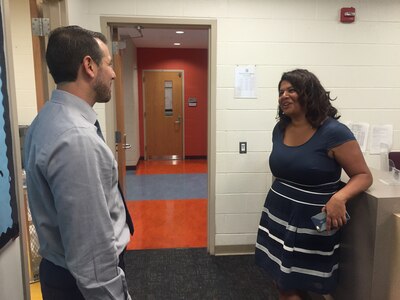It was the first day of school at the Mumford Academy high school and principal Nir Saar was working the hallways, shaking hands, introducing himself to new students.
“There’s the football star!” he said as he greeted a returning 10th-grader. “How you doing, Mr. Varsity?”
He high-fived a girl as she walked by.
“I missed you, Zakiya!” he exclaimed. “How you been?”
“I missed you too,” she answered.
It was a scene similar to ones that played out in schools across Detroit and the nation in the last few weeks as students returned for the start of classes. But for Saar and his students, these routine exchanges came charged with new poignancy: This year could be the school’s last.
The Mumford Academy — a so-called “small learning community” housed within the storied Mumford High School on Detroit’s northwest side — is part of the Education Achievement Authority, a state-run recovery district that took over 15 struggling schools in 2012. After a tumultuous tenure, the district is expected to dissolve next summer and return its schools to Detroit’s main school district.
The Academy’s fate will be decided by a new Detroit school board that will be elected this fall and by the state School Reform Office, which has threatened to close low-performing schools across the state.
The uncertainty rankles, Saar said.
“I’m so emotionally attached to these kids. And these kids are attached to me and to us,” he said. “The idea that this could be torn apart and that that could affect them negatively and their families negatively is the scariest part of it all.”

The Education Achievement Authority has drawn criticism since its creation five years ago when the state abruptly seized the schools and put them under new control without much planning or community discussion. Subsequent financial scandals, enrollment declines, questionable policies and disappointing test scores led to the decision this year to pull the plug on the district.
“I have referred to [the EAA] as a public policy train wreck,” said Michigan State University education professor David Arsen, who has studied the district. “It’s rare that you see something so badly designed that it implodes the way the EAA did.”
Limited funds, a confusing legal status, and strong public opposition have all worked against the EAA. But supporters of the current chancellor, Veronica Conforme, say many of the major missteps were made under the district’s first chancellor, John Covington.
They say Conforme has started turning things around, ushering in key reforms like better teacher training and a stronger focus on academics in the two years since she arrived.
The district continues to post some of the lowest test scores in the state, but most EAA schools showed small improvements on last year’s M-STEP exam.
It’s not likely enough to save the district but Conforme and her supporters are focused on trying to shore up their best programs in hopes that whoever is in charge next year will keep them going.
One of those programs is the Mumford Academy.
The academy is a small, self-contained “learning community” within the larger Mumford High School. Though the state officially only recognizes one Mumford, the EAA treats the academy as a separate school with its own principal.
The academy had just 100 9th graders last year and hopes to add about 100 10th graders this year. The school is small enough, Saar said, that teachers can get to know their students and can help address challenges in their lives that may go unnoticed in a larger school.
Saar keeps class sizes low — about 20-24 students per class last year, he said. And he tries to keep the school focused on instruction by extending the school day by 45 minutes and making sure teachers are supported and well trained.
The effort has shown enough promise that the EAA this year created similar programs in nine other schools in the district, separating out one or two grades from the larger school population. The main Mumford High School now has a new 9th grade “community school.” That means that 9th graders who enroll at Mumford are now randomly assigned to either the Mumford Academy or to the Mumford High School freshman academy. The building now has three principals — Saar, plus one school leader overseeing 10-12th graders and another overseeing another group of 9th graders.
“We’re starting new programs because this is what works for kids,” Conforme said when she stopped by the Mumford Academy Tuesday while making her rounds on the first day of school. “My hope is that we get to preserve this work … because this is what’s working. [The Mumford Academy] is a substantially different place than it was two years ago.”

The Academy doesn’t have much of a public record since it only enrolled ninth-graders last year. That means there are no SAT scores or graduation rates to point to. But Saar says his first year produced impressive results on an exam that measures student progress throughout the year.
“Our growth scores in both reading and math … far exceeded any scores I’ve seen from any of the other schools I’ve worked with,” Saar said. “What we were able to accomplish last year and what I hope we accomplish this year, I hope it makes a statement … And I hope that statement is strong enough to say, ‘No, don’t touch what we’ve got going on over here because it’s working really well.’”
Saar, who is 34, grew up in the Detroit suburbs. He started out as a scientist, earning degrees in biopsychology, molecular biology and history from the University of Michigan. But when he grew tired of working with just a handful of people in a lab after graduation, he joined Teach For America and spent seven years teaching students with disabilities in Philadelphia.
He helped start a non-profit organization called Stay True that matched Philadelphia middle schoolers with service projects until returning to the Detroit area a few years ago to be closer to family.
He worked in various roles for a charter school management company until applying for a principal position in the EAA — a job he says he wouldn’t have considered in the early years of the district.
“I knew about the beginning of the EAA,” said Saar, who joined the district last year. “I had lots of friends and people I knew that were involved in it and it was an utter disaster. It was horrible. But since I’ve been here and since Veronica took charge, this is a really high-functioning district. I’m not sure anybody realizes the caliber of talent and the thoughtfulness of the choices they’re making.”
It’s upsetting to think the new school board could decide to change or close the academy, Saar said, but he’s determined to prove to the board — and to critics who will forever view the EAA as a colossal failure — that there’s good teaching going on in the district.
When the first bell rang on the first day of school this week, Saar, exuded enthusiasm. As he and his staff cheerfully tended to the business of printing out student schedules, re-directing students who were in the wrong place and doling out uniforms on the first day of school, teachers and parents expressed hope that the community they’re building will find a way to survive.
“I like that it’s a small setting and everybody gets to learn,” said Lawanda Richardson, whose son, Raymond Johnson, is starting in the school’s ninth grade this year.
She had anxiously read a news report the day before classes began that cast doubt on school’s future but says she has faith that the good work there will continue. “We’re hoping that it will be saved,” she said.
Matthew Guyton, a 32-year-old geometry teacher who joined the staff of the Mumford Academy this year after four years at the main Mumford High School, says there’s something special going on at the school.
“Even going to our professional development last week, it felt different,” he said. “It felt like a team.”

The small, family-like school reminds him of a teaching job he had in the Upper Peninsula, he said. “This is what normal feels like. The kids are actually polite. They’re eager. That’s the culture that they’ve built here.”
Exactly what will happen to EAA teachers when the schools return to main Detroit school district next year isn’t clear. The teachers, who are not represented by the teachers union, earn salaries that don’t align with those prescribed by Detroit’s contract with its teachers union.
Novice EAA teachers make $45,000, compared to first-year Detroit public school teachers who start as low as $36,000, though Detroit district teachers can eventually earn salaries that exceed top EAA pay.
Saar says his school faces many challenges. Chronic absenteeism is an issue, and many of his students arrive significantly behind grade level.
But, now, he said, his biggest challenge is politics.
“This will be an existential year,” he said. “It’s an existential moment for us … We’ve got to prove it beyond a shadow of a doubt so that anybody that cares about kids will look at what we have going on here and say, you know, this can’t go anywhere. We can’t touch this. “


